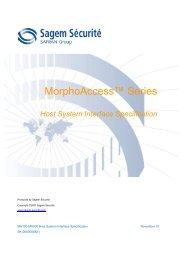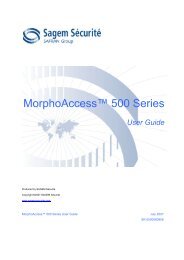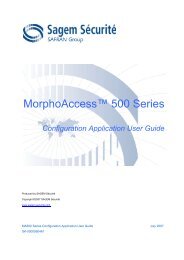MorphoSmartTM Overview
MorphoSmartTM Overview
MorphoSmartTM Overview
Create successful ePaper yourself
Turn your PDF publications into a flip-book with our unique Google optimized e-Paper software.
MorphoSmart <strong>Overview</strong><br />
3.1 About Fingerprints<br />
Version 1.8 June 2006<br />
Sagem Défense Sécurité Document - Reproduction and disclosure prohibited<br />
SAGEM Défense Sécurité<br />
3 Fingerprint Basic Knowledge<br />
Fingerprints are permanent and unique. They are formed before birth and last throughout one's life.<br />
Classification and systematic matching of fingerprints for different purposes have been in use since<br />
the late 19th century.<br />
Ridge Ending<br />
Ridge Bifurcation<br />
Figure 1: Minutiae are classified in two categories: Ridge ending and bifurcation<br />
Present on your fingers is skin, which is different from that on other areas of your body. This skin is<br />
rough or corrugated, consisting of raised portions that are called ridges. These ridges do not run<br />
continuously from one side to the other, rather they may curve, end, or divide into two or more ridges<br />
(bifurcation and endings). Barring accidental or intentional mutilation, the ridge arrangement is<br />
permanent. Fingerprints can be divided into major ridge pattern type such as Whorls, Loops and<br />
Arches etc. Unique characteristics known as Minutiae identify those points of a fingerprint where the<br />
ridges become bifurcation or endings, as illustrated in Figure 1. These minutiae are the unique<br />
features, which form the basis of any system using fingerprint comparison techniques for<br />
identification and verification purposes.<br />
3-9






